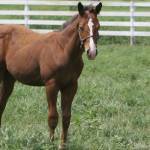Physitis in Growing Horses

Inflammation and swelling around the growth plates of various long bones in young horses is known as physitis. As with other developmental orthopedic diseases, the causes of physitis are not completely understood. Nutritional imbalances, problems with bone maturation, conformation defects, abnormal hoof growth, excessive exercise, running on hard ground, obesity, and too-rapid growth have all been blamed, and it is possible that the condition is caused by more than one factor.
Physitis is frequently seen in heavy, fast-growing foals during the summer when the ground is dry and hard. It is also encountered on breeding farms where the dietary ratio of calcium and phosphorus is unbalanced. In these situations, an overload of concussion on the growth plates along with maturation defects in bone or cartilage could trigger lameness and swelling, even if neither factor alone would create a significant problem.
In some cases, obvious osteochondrosis is present, and retained cartilage and lipping at the edges of the physis are seen radiographically. Rapid growth may cause increased flaring due to greater periosteal tension at the physeal attachment. In other instances, young horses present with lameness and swelling associated with the physis, but no abnormalities can be seen on radiographs. In some cases, microfractures may be involved but can’t be easily detected.
Physitis is usually noticed when horses are between four and eight months of age, although horses as old as two years of age are occasionally affected. The most common locations are the distal radius and distal metacarpus or metatarsus. The first phalanx and distal tibia are less commonly affected. The actual degree of lameness varies between horses.
The treatment of physitis is aimed at correcting any possible nutritional deficiencies, excesses, or imbalances, but in many instances none of these are recognized. The foals are usually confined to some extent and the amount of confinement versus exercise is balanced by careful observation. Restriction of exercise is indicated when moderate to severe lameness is present, and nonsteroidal anti-inflammatory drugs may relieve discomfort. In most instances, the prognosis for natural resolution of the problem is good. Physitis is normally a self-limiting disease, with the problem disappearing as skeletal maturity is reached and growth at the affected physis ceases.








